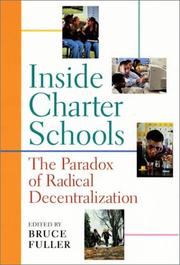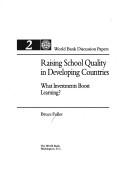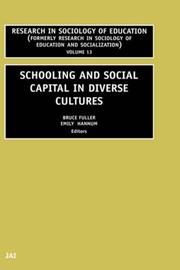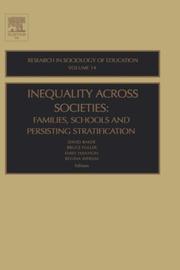| Listing 1 - 9 of 9 |
Sort by
|

ISBN: 0674037421 9780674037427 067400325X 0674008235 Year: 2000 Publisher: Cambridge, MA : Harvard University Press,
Abstract | Keywords | Export | Availability | Bookmark
 Loading...
Loading...Choose an application
- Reference Manager
- EndNote
- RefWorks (Direct export to RefWorks)
Deepening disaffection with conventional public schools has inspired flight to private schools, home schooling, and new alternatives, such as charter schools. Barely a decade old, the charter school movement has attracted a colorful band of supporters, from presidential candidates, to ethnic activists, to the religious Right. At present there are about 1,700 charter schools, with total enrollment estimated to reach one million early in the century. Yet, until now, little has been known about the inner workings of these small, inventive schools that rely on public money but are largely independent of local school boards. Inside Charter Schools takes readers into six strikingly different schools, from an evangelical home-schooling charter in California to a back-to-basics charter in a black neighborhood in Lansing, Michigan. With a keen eye for human aspirations and dilemmas, the authors provide incisive analysis of the challenges and problems facing this young movement. Do charter schools really spur innovation, or do they simply exacerbate tribal forms of American pluralism? Inside Charter Schools provides shrewd and illuminating studies of the struggles and achievements of these new schools, and offers practical lessons for educators, scholars, policymakers, and parents.
Charter schools --- Schools --- Education and state --- Public institutions --- Education --- Decentralization

ISBN: 0821308467 Year: 1986 Publisher: Washington (D.C.): World Bank
Abstract | Keywords | Export | Availability | Bookmark
 Loading...
Loading...Choose an application
- Reference Manager
- EndNote
- RefWorks (Direct export to RefWorks)
Education --- Aims and objectives --- Finance

ISBN: 0762308176 1849508852 Year: 2006 Publisher: Amsterdam JAI
Abstract | Keywords | Export | Availability | Bookmark
 Loading...
Loading...Choose an application
- Reference Manager
- EndNote
- RefWorks (Direct export to RefWorks)
One of the most seductive topics in recent years is the field of social capital - the webs of trust, mutual obligation, and cultural knowledge that flow through local information - that yield resources in human-scale associations of individuals. When we ask about the implications for children's learning and performance in the school institution, however, the construct quickly becomes slippery to hold. The 2001 volume provides five papers that offer empirical evidence on the nature and life of social capital across diverse ethnic groups and cultural settings. These fresh studies delve into the resources embedded in Latino and Asian-American peer groups, how immigrant parents' networks and norms variably push their children to achieve in school, and how teenagers' involvement in ethnic-rooted churches contribute social capital. The volume includes three commentaries, authored by David Baker, Patricia Fernandez-Kelly, and Raymond Wong, and a review chapter by the editors.
#SBIB:316.334.1O340 --- Onderwijs en sociale verandering, onderwijs en samenleving --- Educational sociology --- Social capital (Sociology). --- Social capital (Sociology) --- Capital, Social (Sociology) --- Sociology --- Education and sociology --- Social problems in education --- Society and education --- Sociology, Educational --- Education --- Aims and objectives
Book
ISBN: 027593831X Year: 1992 Publisher: New York (N.Y.) : Praeger,
Abstract | Keywords | Export | Availability | Bookmark
 Loading...
Loading...Choose an application
- Reference Manager
- EndNote
- RefWorks (Direct export to RefWorks)
Education and state --- Education --- Economic aspects --- Political aspects --- Education and state. --- Historische en vergelijkende pedagogiek. --- Economic aspects. --- Political aspects.
Book
ISBN: 0821319329 Year: 1992 Publisher: Washington (D.C.) World Bank
Abstract | Keywords | Export | Availability | Bookmark
 Loading...
Loading...Choose an application
- Reference Manager
- EndNote
- RefWorks (Direct export to RefWorks)
Educational change --- Education and state --- Education --- Congresses --- Finance

ISBN: 0762310618 1849502412 9786611016166 1281016160 0080473032 9781849502412 9780080473031 9780762310616 9781281016164 6611016163 Year: 2009 Publisher: Bingley Emerald Group Publishing Limited
Abstract | Keywords | Export | Availability | Bookmark
 Loading...
Loading...Choose an application
- Reference Manager
- EndNote
- RefWorks (Direct export to RefWorks)
Most societies place great faith in the modern school's power to offer children a more prosperous future, from better jobs to wider social opportunities. In turn, political leaders around the world push to expand western forms of schooling, creating more slots for children, from preschool through university levels. Yet despite this remarkable institutional change, are societies becoming equitable, especially for those groups living on the margins of civil society? Why, in too many cases, has schooling failed to deliver on its promise of reducing economic and social disparities? This volume addresses these questions, taking the reader into a variety of nations and cultural settings. With studies from Europe, the Middle East, Africa, and Asia, the volume illuminates how schools can reduce or reinforce the layered stratification of society, even in nations with non-western traditions. The contributors, diverse in their own origins and viewpoints, advance our understanding of stratification by highlighting how a nation's history, particular institutions, and cultural context shape the school's efficiency as an agent of equity. The chapters move beyond individual conceptions of attainment and distinguish near-universal versus country-specific mechanisms that characterize the interplay between school expansion and inequality. It shows how schools can reduce or reinforce the layered stratification of society, even in nations with non-western traditions.
Educational equalization --- Educational sociology --- Income distribution --- Social stratification --- #SBIB:316.334.1O340 --- 316.34 --- 316.34 Sociale differentiatie. Sociale typologie. Sociale stratificatie --- Sociale differentiatie. Sociale typologie. Sociale stratificatie --- Stratification, Social --- Equality --- Social structure --- Social classes --- Distribution of income --- Income inequality --- Inequality of income --- Distribution (Economic theory) --- Disposable income --- Education and sociology --- Social problems in education --- Society and education --- Sociology, Educational --- Sociology --- Education --- Onderwijs en sociale verandering, onderwijs en samenleving --- Aims and objectives --- Educational sociology. --- Social stratification. --- Educational equalization. --- Income distribution. --- Education. --- Social discrimination. --- Social Science --- General. --- Popular Culture. --- Educational equality --- Educational equity --- Educational inequality --- Equal education --- Equal educational opportunity --- Equality of education --- Equalization, Educational --- Equity, Educational --- Inequality, Educational --- Opportunity, Equal educational --- Affirmative action programs in education
Book
ISBN: 0195208722 Year: 1991 Publisher: Oxford [etc.] : Oxford University Press,
Abstract | Keywords | Export | Availability | Bookmark
 Loading...
Loading...Choose an application
- Reference Manager
- EndNote
- RefWorks (Direct export to RefWorks)
Education --- -Education, Elementary --- -Children --- Elementary education --- Primary education (Great Britain) --- School children --- Children --- Education, Primitive --- Education of children --- Human resource development --- Instruction --- Pedagogy --- Schooling --- Students --- Youth --- Civilization --- Learning and scholarship --- Mental discipline --- Schools --- Teaching --- Training --- Statistics --- Education (Elementary) --- -Statistics --- Education, Elementary
Book

Year: 2005 Publisher: Cambridge, Mass. National Bureau of Economic Research
Abstract | Keywords | Export | Availability | Bookmark
 Loading...
Loading...Choose an application
- Reference Manager
- EndNote
- RefWorks (Direct export to RefWorks)
Previous research has demonstrated that attending center care is associated with cognitive benefits for young children. However, little is known about the ideal age for children to enter such care or the "right" amount of time, both weekly and yearly, for children to attend center programs. Using national data from the Early Childhood Longitudinal Study (ECLS-K), this paper asks whether there are optimal levels of center care duration and intensity and whether these levels vary by race or income. We consider pre-reading and math skills as measured by assessments administered at the beginning of kindergarten, as well as teacher-reported social-behavioral measures. We find that on average attending center care is associated with positive gains in pre-reading and math skills, but negative social behavior. Across economic levels, children who start center care between ages two and three see greater gains than those who start centers earlier or later. Further, starting earlier than age 2 is related to more pronounced negative social effects. Results for center intensity vary by income levels and race. For instance, poor and middle-income children see academic gains from attending center intensively (more than 30 hours a week), but wealthier children do not; and while intense center negatively impacts Black and White's social development, it does not have any negative impact for Hispanic children.
Book

Year: 2003 Publisher: Cambridge, Mass. National Bureau of Economic Research
Abstract | Keywords | Export | Availability | Bookmark
 Loading...
Loading...Choose an application
- Reference Manager
- EndNote
- RefWorks (Direct export to RefWorks)
Young children in poor communities are spending more hours in non-parental care due to policy reforms and expansion of early childhood programs. Studies show positive effects of high-quality center-based care on children's cognitive growth. Yet we know little about the effects of center care typically available in poor communities or the effects of home-based care. Using a sample of children age 12 to 42 months when their mothers entered welfare-to-work programs, this paper finds positive cognitive effects for children in center care. Children also display stronger cognitive growth when caregivers are more sensitive and responsive, and stronger social development when providers have education beyond high school. Children in family child care homes show more behavioral problems but no cognitive differences.
| Listing 1 - 9 of 9 |
Sort by
|

 Search
Search Feedback
Feedback About UniCat
About UniCat  Help
Help News
News